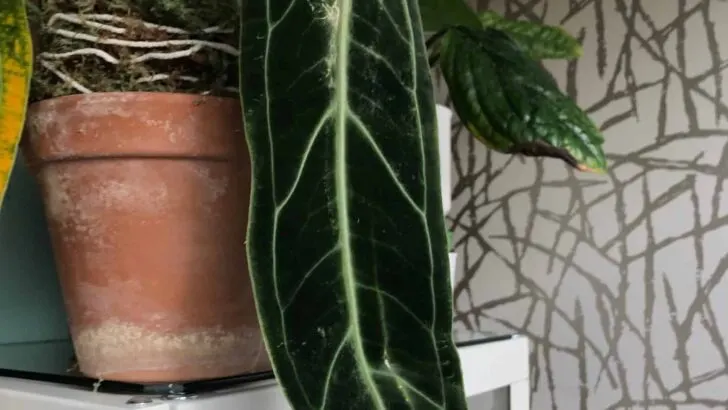Are you interested in Anthurium warocqueanum care? The Anthurium warocqueanum can grow immense leaves under proper care. The care for the Queen Anthurium is certainly not easy and not suggested for the beginner.
I will highlight all relevant aspects, from soil to the correct watering to general problems with this Anthurium.
Table of Contents
Anthurium warocqueanum Takeaways
| Species | Anthurium warocqueanum |
| Synonyms | King Anthurium |
| Family | Araceae |
| Genus | Anthurium |
| Growth | Pendant leaves growing from a crown |
| Height | 6.6 feet |
| Width | 4 feet |
| Soil | Well-draining potting mix consisting of potting soil, perlite, orchid bark and peat moss |
| Watering | Every 5 to 7 days |
| Light | Bright indirect feet |
| Temperature | 68 - 86°F |
| Humidity | 70 to 90% |
| Fertilizer | Fertilize 4 month |
| Propagation | Division |
Anthurium warocqueanum care
To care for Anthurium warocqueanum provide well-draining potting soil and bright indirect sunlight. 100% Sphagnum moss or an aroid mix of perlite, orchid bark, charcoal, peat moss, and potting mix. A temperature between 68-86°F (20-30°C) and watering once a week on average. Humidity should be at 70% or more for optimal conditions. Fertilize weekly with liquid fertilizer at 1/4 of the recommended strength.
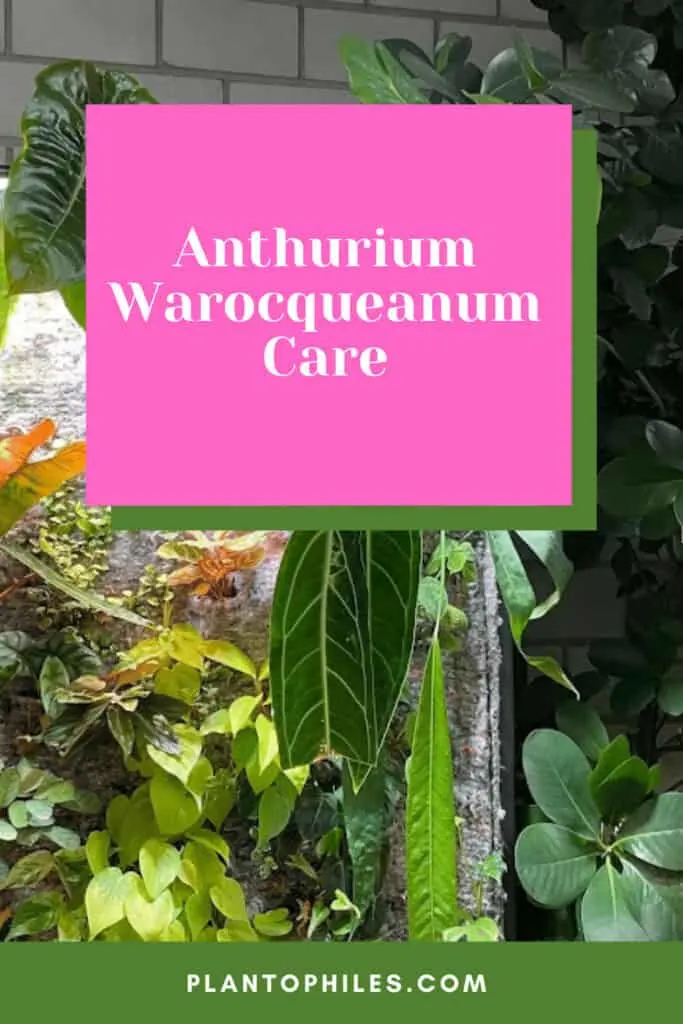
The Anthurium warocqueanum Plant
Anthurium warocqueanum belongs to the Anthurium genus of 1000 flowering species. Anthurium is the largest genus in the Araceae family, with a big diversity across northwestern South America.
This houseplant is often referred to as the Queen Anthurium.
Naming it the Queen Anthurium as the Anthurium veitchii is called the King Anthurium is a fair point, although some people will refer to it as the King.
The leaves on this plant are pendent and as thick as cardboard. They have dark green velvety leaf blades.
Thick and sturdy leaves are called coriaceous in plant botany terms.
Other plants in the Aroid family are the Monstera genus with the Monstera Deliciosa and all the Philodendron plants such as the Philodendron Gloriosum.
Anthurium warocqueanum was chosen to honor the Belgian plant friend M. Warocqué.
Anthurium belongs to the section cardiolonchium as do the Anthurium crystallinum and Anthurium magnificum.
The Anthurium warocqueanum distribution is central to western Colombia, according to the University of Connecticut, where it grows in the lowlands and valleys in the Depts. of Antioquia and Choco and Valle.
These plants are growing epiphytic in lower mountain regions and rainforests from elevations of about 660 feet – 4600 feet (200m – 1400m).
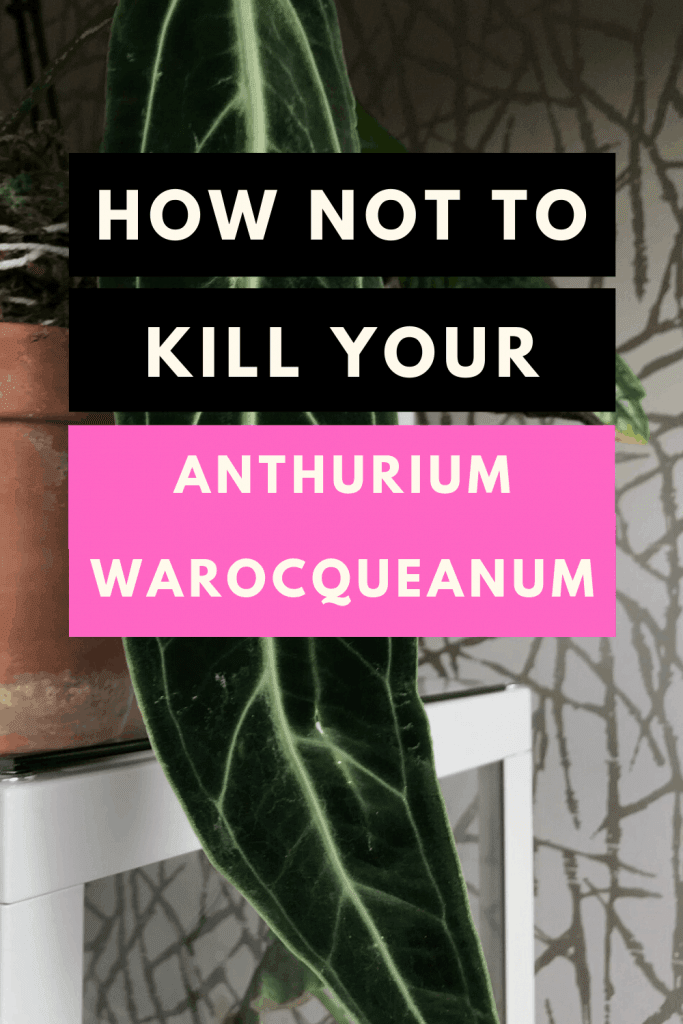
Queen Anthurium warocqueanum Care Guide
Anthurium warocqueanum Soil
Grow Anthurium warocqueanum in 100% Sphagnum moss or an aroid mix of potting mix, perlite, orchid bark, and peat moss.
These plants do not tend to grow in soil.
The Queen is an epiphyte. Epiphytes are plants growing on other plants instead of in the soil.
In nature, they grow in moss, leaf litter, and any debris they might come across in tree branches.
A loose, breathable, very airy mix is a must.
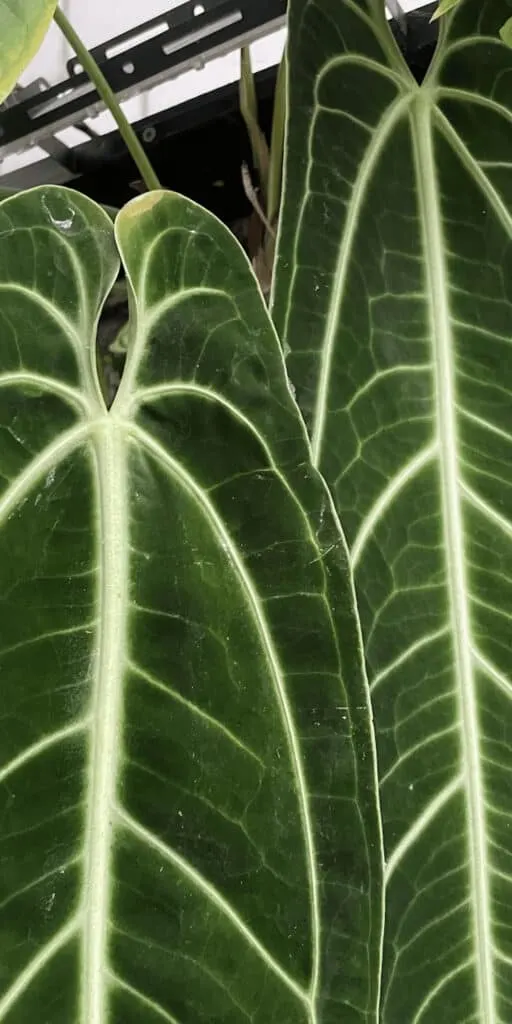
The substrate I am using is 100% Sphagnum moss, and the Anthurium warocqueanum seems to love it.
A great suggestion is to provide Sphagnum Moss along the whole stem of your plant.
This way, the Anthurium warocqueanum will develop roots all along the stem.
Other growers are successfully growing it in an airy and well-draining aroid mix.
Yet others are growing it in a mix between coarse bark and Sphagnum moss.
Whatever medium you use needs to be well-draining and hold moisture simultaneously.
Keep the pH level between 6.6 – 7.5 between acid and neutral.
What light is best for a Queen Anthurium?
Bright indirect light is best for Anthurium warocqueanum.
Lots of bright indirect light is best in indoor conditions. This way, your Anthurium plant will grow the best.
They generally need more light than usually advised, as most people base their judgment on how these plants grow in situ in their natural habitat.
They might be in semi-shade, but one must remember that sunlight is usually so much stronger than anything that we can provide an Anthurium warocqueanum indoors.
Avoid direct sunlight, as this will burn the leaves of your indoor plant.
Read my guide on lighting for plants to find the perfect spot in your house.
Watering
Water Anthurium warocqueanum frequently, about once a week, and never let it dry out completely.
If watered infrequently and if you let the soil stay dry for several days, the Queen will start to get crispy leaves.
Leaf edges will start to become very dry.
Anthurium warocqueanum is a thirsty plant.
I heard other growers say the opposite on the internet about how you should not water these plants as you would water a Monstera or any other Philodendron.
This makes no sense to me as these plants are from tropical rainforests where it tends to rain almost daily.
I water mine weekly by giving it a thorough shower.
Since my plant is in 100% Sphagnum moss, it will soak up the water and keep the plant hydrated for a full week just until the moss gets crispy again.
Never let this plant dry out completely.
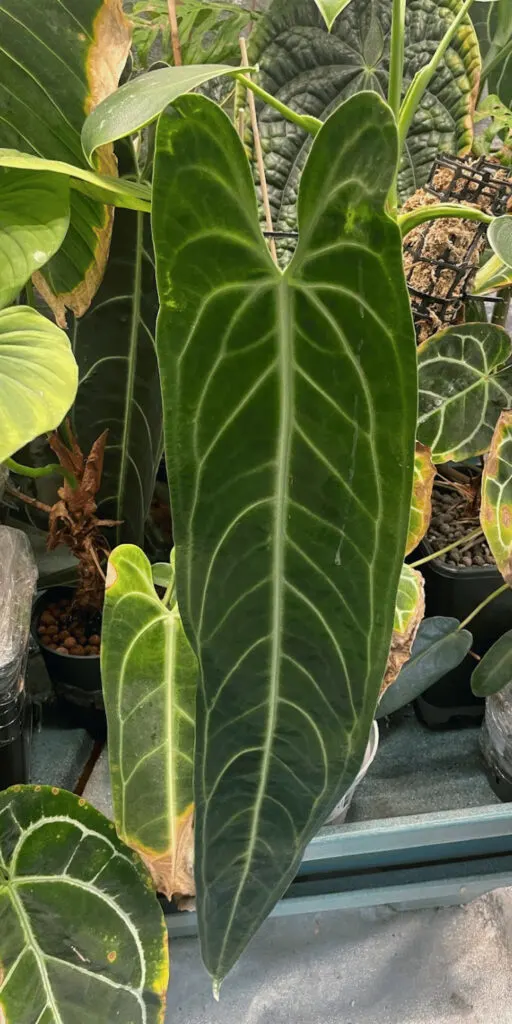
Temperature
Anthurium warocqueanum grows best in a temperature between 68-86°F (20-30°C).
Anthurium warocqueanum humidity
Provide 70% or more humidity for Anthurium warocqueanum.
These plants need very high humidity. This doesn’t mean they cannot grow and survive in lower humidity, but humidity above 70% is best.
Make sure you are providing sufficient air exchange. Air circulation is very important to an Anthurium warocqueanum.
They are susceptible to damage on the leaves when the airflow is insufficient.
If you are growing your Anthurium in a terrarium or greenhouse, you need to ensure that you are using fans to allow air circulation.
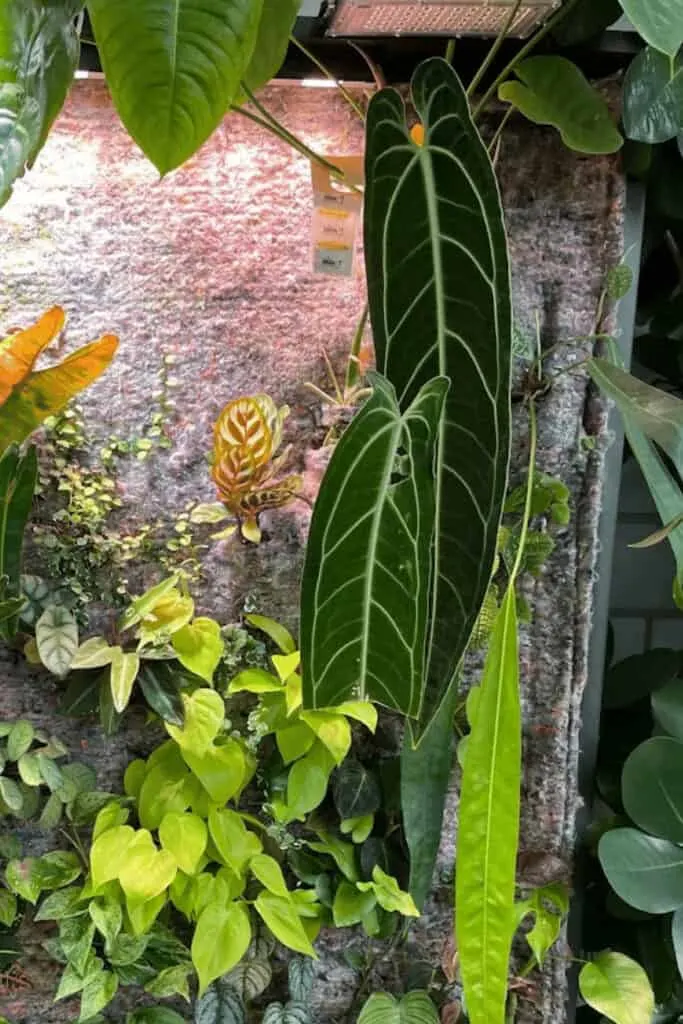
Fertilizer
Fertilize Anthurium warocqueanum weekly but weakly with liquid fertilizer at 1/4 the recommended strength throughout the year.
Since Anthurium warocqueanum is epiphytic, they get little nutrients found in the debris of tree branches, such as from rotting leaves and what the wind and rain bring to them.
However, many experienced growers suggest fertilizing them frequently, like weekly throughout the year.
A quarter of the proposed strength of e.g., a liquid fertilizer is sufficient.
If you want to learn more about nutrients and the NPK values on fertilizers you can read my complete guide.
Anthurium warocqueanum propagation
Propagate Anthurium warocqueanum from new crowns that will emerge from the trunk (stem) of the plant. Propagation is done by division.
Anthurium warocqueanum Growth Rate
The Anthurium warocqueanum grows leaves up to a length of 6.6 feet (2 meters) within 2-3 years.
The abaxial side of the leaves is velutinous and has visible silvery veins that become increasingly prominent the bigger the leaves grow.
What is interesting is that new leaves are starting very small and are then expanding.
Most Monstera and Philodendrons give you a good idea of how big leaves will get upfront.
Not with the Anthurium warocqueanum. Its leave starts small and can get very big within days.
A good indicator that your Anthurium warocqueanum is happy is when it is keeping its leaves.
If the care is not ideal, these plants will always lose a leaf when forming a new one or lose all of the leaves altogether.
So take the number of leaves on this plant to indicate plant happiness.
0 means the condition is critical, one is barely surviving, and anything above two leaves means you are doing a great job.
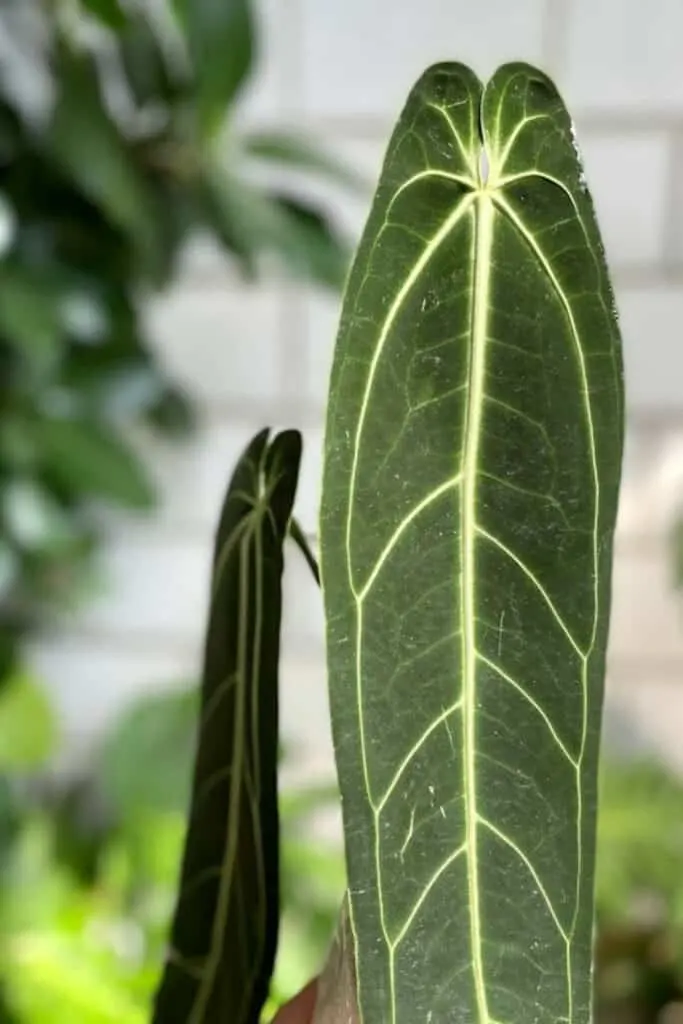
Potting
Anthurium warocqueanum is best potted into wooden orchid baskets.
These are a great way to support their epiphytic growing habit.
The roots can attach to the wood or grow out of the basket. In nature, the roots are venturing down and to the sides quite often.
A wooden basket supports this growing habit perfectly.
Although a wooden orchid basket might be the best, I am growing mine in a clay pot. It has a drainage hole in the bottom, and the clay is porous and allows for air exchange.
The advantages of clay pots can be read in my terracotta pot article.

Anthurium warocqueanum Propagation
Propagation from seeds is feasible, but there are not many records of successful propagations from seeds.
A different way is propagation from division. They are producing offsets from time to time that can be removed from the plant and that will grow into a new plant.
How to propagate Anthurium warocqueanum step-by-step:
- Look for offshoots on your plant
- Use a pruning shear, knife, or scissors that are disinfected beforehand. Disinfect using rubbing alcohol and holding under a flame for a few seconds.
- Cut the offshoot section and ensure that roots are present on the cutting in the best case.
- Put cinnamon on the wounds of the offshoot and the main plant
- Put the offshoot in damp Sphagnum Moss
- Ensure a humid and warm environment so roots can produce quickly on your cutting.
- Voila you have a new baby Anthurium warocqueanum
From a pleasant topic to a not-so-pleasant one. Let’s now have a look at common problems.
Anthurium warocqueanum seeds
Anthurium warocqueanum seeds are brown to green and 0.2-0.3 inches long.
Seeds are produced when an inflorescence is pollinated. These plants go through a female and male phase. The female phase is when the flower is receptive. The spadix produces sticky sap during the female phase.
This is when the inflorescence of Anthuriums can be pollinated. Once the female phase is over, the plant goes into the male phase. In that phase, the pollen is produced. So to get seeds, you need to pollinate the Queen Anthurium in the female phase.
If the pollination is successful, the spadix swells and produces berries.
It then takes several months to a year until the berries are viable. The berries themselves contain the seeds.
Anthurium seeds are only viable for a couple of months. Be careful when buying them off the internet.
Anthurium warocqueanum flower
The flower on an Anthurium warocqueanum is nothing special. They grow a spathe, which is a modified leaf, as well as a spadix. The spadix is upright and contains tiny flowers.
The plants need to mature first before they can flower.
Anthurium warocqueanum Dark Form
There is said to be a dark form of Anthurium warocqueanum, as well as wider and more narrow forms. It is also called Anthurium warocqueanum dark knight. I cannot confirm this form truly exists based on my experience with this plant.
The Queen Anthurium will look much darker if you grow it in lower light. It has a brighter green when growing under high light. The only reason for this is that the plant leaves adapt and regulate light intake.
Understandably, people started thinking that there are two distinct forms. The same goes for wider and more narrow leaves.
Why are the leaves damaged on my Anthurium warocqueanum?
The velvety thick leaves are getting damaged easily. A common cause is if water remains on the surface of the leaves for too long.
Bacterial infection in the form of brow circles with yellow hues is the visible damage that can be spotted.
The best countermeasure against this is to allow for sufficient air circulation. Wet leaves need to be able to dry quickly.
A different cause can be the rough handling of the leaves. As an example, these houseplants do not like to be shipped.
Damaged leaves in the form of slits and broken leaves are often the result.
They often get severely damaged after shipping and must be trimmer or fall off entirely.
The damage itself if it’s not bacterial on the leaves, is not a big issue for the plant, and the leaf can stay on it.
It is more that it can be unappealing for the eye, which is why some people will decide to cut off damaged leaves or sections of it.
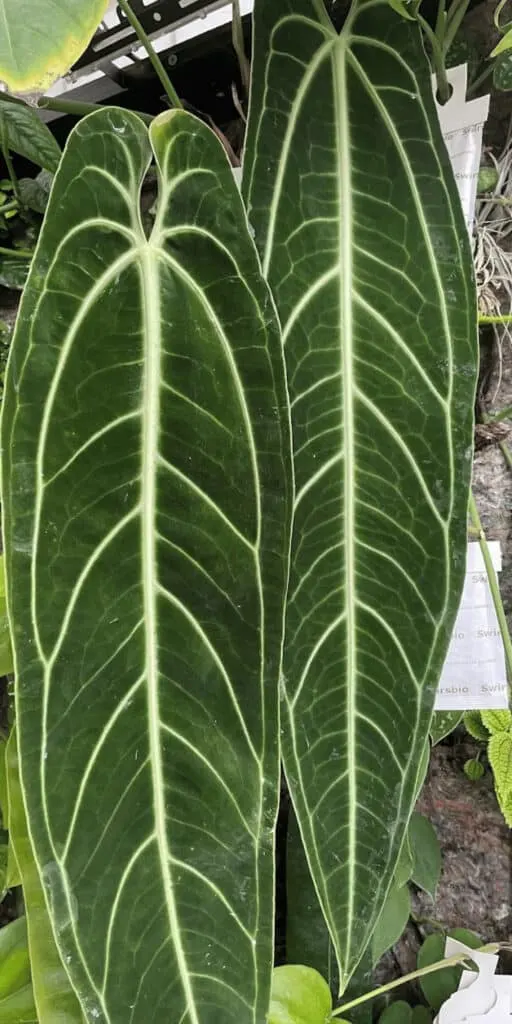
Why does my Queen Anthurium have Brown Leaves?
Brown leaves can cause your plant to be sunburnt because of too much sunlight. Other reasons might be nutrient deficiencies as well as underwatering.
To get to the root cause, let’s look at sunburn. In most cases, multiple leaves will show browning caused by too much direct sunlight.
If nutrients are not readily available, your Anthurium warocqueanum can develop brown leaves. Make use of a liquid or slow-release fertilizer to counter nutrient deficiency.
Last but not least, we have the most likely cause of browning leaves, if sunburn can be ruled out, underwatering.
Anthuriums do not like to dry out completely. Specifically, the Anthurium warocqueanum likes to stay lightly moist and should never dry out completely as this might lead the plant to go downhill quickly.
Let’s now move over to yellow leaves.
Anthurium warocqueanum yellowing
Yellow leaves on Anthurium warocqueanum can have many different reasons, such as overwatering, underwatering, stress, nutrient deficiency, and not enough humidity, or the cause can be natural, as old leaves will turn yellow and fall off at some point.

However, I would say the most common reason is overwatering. Whenever leaves turn yellow on my plant, and it is not the oldest leaf, I will check the roots.
This should be fairly easy as Anthurium warocqueanum is an epiphytic plant and shouldn’t be in a dense substrate.
If the roots are brown and mushy, you can look at the next section on what to do about it.
I have Black Mushy Roots on my Warocqueanum
Black mushy roots are a bad sign. Not everything is lost, but it is a sign that you must act fast.
If you spotted that roots come easily off your plant and feel mushy and rotten, you are dealing with root rot on your Anthurium.
I wrote a whole article about spotting and treating root rot that you can consult in addition.
In a nutshell, what you have to do is to remove soft and mushy roots that are black. Sniping them off with a disinfected pruning shear or scissors just above the rotting sections is best.
Since rooting can easily transfer over to healthy roots, it is important that you remove these unhealthy roots.
Once this is done, wash the remaining roots thoroughly under running water in your sink.
Then you will have to disinfect your pruning shears or scissors again so you are not transferring the infection to a different plant you might be cutting next.
Now you will have to change the substrate your Anthurium warocqueanum is in completely and disinfect the pot it was in.
The pathogens leading to root stay in the soil and your pot, and you need to get rid of them for good to stop the spread.
If you would not do anything about the rooting roots it would spread quickly to the rest of the roots and would kill your entire plant in no time.
Pests
Like most other houseplants, Anthuriums such as the Anthurium warocqueanum are prone to be attacked by plant pests.
Common pest infestations are mealybugs, aphids, thrips, scale, and spider mites.
To make your life easier, I have written extensive articles on each of these pests and how to counter them. You can follow the links above.
It is best practice to check for pest infestations frequently. I would suggest checking your plants every few days and looking at the underside of the leaves.
The earlier you spot pests on your plants, the easier to eliminate them.
Anthurium warocqueanum for sale
There are multiple shops only where you can buy a Queen Anthurium. Some of my favorite online shops are:
Anthurium warocqueanum ‘Esmeralda’
Anthurium warocqueanum Esmeralda is a warocqueanum cultivar that is easier to care for. It features long, pendent green leaves but has much greener veining. The coloring is lighter, and the leaves are even more velvety.
Anthurium warocqueanum x waterburyanum
This is a cross between Anthurium warocqueanum and Anthurium waterburyanum. This cultivar produces wide, tall pendent leaves. The care is similar to the Queen Anthurium but considered easier. This is the case for most crosses. Other crosses are Anthurium warocqueanum x papillilaminum and Anthurium warocqueanum x crystallinum.
Frequently Asked Questions
Why is my Anthurium warocqueanum dying?
There are many different reasons why an Anthurium warocqueanum could be dying. The reason can be underwatering, overwatering, a pest infestation or the substrate can be the wrong choice. The best is to look at the foliage as the leaves will tell you what is wrong with your plant.
Why does my plant loose leaves?
Losing leaves indicates that your Anthurium warocqueanum care is not on point. It is quite common for Anthurium warocqueanum to shed its leaves and only maintain one of the leaves if the conditions it is kept in terms of humidity, watering, temperature, substrate, and fertilizer are suboptimal.
Why are the leaves on my Anthurium warocqueanum turn yellow?
Yellowing can have many reasons such as overwatering, underwatering, an old leaf turning yellow naturally, not having enough nutrients, and stress. The next step is to rule out all the different reasons to find the cause and thus adjust the care.
How to propagate an Anthurium warocqueanum?
Anthurium warocqueanum can be propagated from new crowns building on the plants. Once these start to build roots, they can be removed by cutting them off and be put into their pot and substrate.
Should I mist my Anthurium?
High humidity is vital for your Anthurium warocqueanum. The humidity level should be kept above 70% if possible. Misting your plant daily is a great idea as long as you can ensure sufficient airflow will dry the leaves quickly. Otherwise, bacterial leaf spots can start to form on the foliage.
Conclusion
I would not describe Anthurium care as particularly easy. The Anthurium warocqueanum is no exception.
To best care for this aroid, choose a suitable pot as an orchid basked and a proper potting mix.
Sticking with pure Sphagnum moss or a mix of Moss and coarse orchid bark is a great choice.
In addition, allow for high humidity above 70% if possible and ensure good airflow to the leaves.
If you can fulfill these needs, you are off to a good start with your Anthurium warocqueanum.
What are your best practices for caring for an Anthurium warocqueanum?

Daniel has been a plant enthusiast for over 20 years. He owns hundreds of houseplants and prepares for the chili growing seasons yearly with great anticipation. His favorite plants are plant species in the Araceae family, such as Monstera, Philodendron, and Anthurium. He also loves gardening and is growing hot peppers, tomatoes, and many more vegetables.

